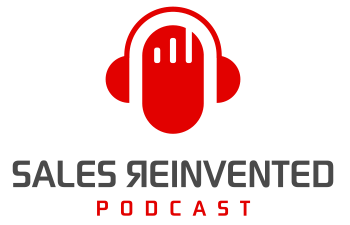Episode #414: Valentyn Kokoshko

Meet
Valentyn Kokoshko
Valentyn is a cold-calling professional. He led a team of 25 SDRs at Selling.com. Today, Valentyn helps companies build an effective cold-calling channel by training their SDRs on how to cold-call effectively. He has trained over 60 specialists in various industries including SaaS, outstaffing, and IT.
Our Mission Is To Change The Negative Perception Of Sales People
Our Vision Is A World Where Selling Is A Profession To Be Proud Of
Cold-calling currently remains the only personal approach to interacting with a prospect that can’t be replicated by AI. That’s why the conversation you have is incredibly important. Valentyn Kokoshko believes that if you follow some simple rules on your calls. Valentyn lays out his efficient and effective process in this episode of Sales Reinvented.
How Valentyn prepares for cold-calling
One of Valentyn’s favorite techniques involves breathing. When you take a deep breath, it helps you shift away from your current state of mind. You have to think of a situation where you are in a state of mind that is desired for you right now. You have to teleport there and feel that with your body.
If you’re irritated and want to stay calm, you take a deep breath and imagine you’re lying on the beach in the sun. You have to feel the sun, feel the breeze, etc. Then you take another deep breath and come back to reality. The more you practice this, the easier it becomes.
It helps reduce the anxiety that comes with picking up a phone and dialing. It helps you control your emotional state.
You can also listen to music, meditate, pray—whatever helps.
How Valentyn uses permission-based openers
Permission-based openers are effective if you follow certain rules. Valentyn says “Hey this is Valentyn, we’ve never spoken before, would you mind if I grab a minute to tell you why I’m calling?”
He says his name (usually not where he’s calling from), admits that it’s an unexpected call, and asks for permission to take up a minute of their time to share why he’s calling. You always need a reason to contact them. If you ask someone for something without a reason, you’re less likely to hear a yes.
Valentyn is behind scripting. But he emphasizes that you can’t read a script word-for-word. It’s a structure that should guide you. You can still vary your script to match your prospect or handle objections.
How Valentyn handles objections
What objections could you face based on your product or service? Prepare for those. Jordan Belfort taught that there are only three core objections:
- They don’t trust you
- They don’t trust your company
- They don’t see the value in what you sell
If you keep this in mind, you can build the answers to objections around it.
No matter what you sell, you’ll likely ask for a meeting, and someone will say, “Send me an email.” Instead, say, “Yes, I’ll definitely send you an email. But how can I put everything that would be relevant to you in a single email?” Then you stay silent.
They’ll think about it and realize that you’d be writing them a book, have follow-up questions, and they’d end up spending more time writing back and forth. With a phone call, the conversation is quickly tailored to the prospect’s needs, and their time isn’t wasted.
Most of them say, “Yeah, that makes sense. I’ll give you 15 minutes.” If you do everything correctly, follow your script, listen actively, make your discovery, collect information, offer a value proposition that answers their pain points, and cater your call-to-action to them, you’ll face zero objections.
Connect With Paul Watts
Audio Production and Show notes by
PODCAST FAST TRACK
https://www.podcastfasttrack.com
Learn More About Valentyn Kokoshko
What was a pivotal moment or experience in your career that shaped your approach to cold calling, and how did it change your perspective or strategy? I remember when I joined Selling.com and saw how their SDRs were making calls, talking to strangers, and booking meetings. It was impressive! I realized how many opportunities this channel and skill could give me and how many doors it could open. I immediately started learning how to make calls, carry conversations, and handle objections. Calling is a vital channel for me ever since.
Can you share a specific tactic or approach you’ve used in cold calling that significantly increased your success rate? Please provide a brief example or case study. Don’t start with a company presentation, ask open-ended questions, and give your prospect a reason to say “Yes” to you.
Cold calling often comes with its set of challenges and rejections. Can you share a particularly tough challenge you faced while cold calling and how you overcame it? The toughest challenge is to think fast and react fast while on the phone to move the conversation in the direction you want. It requires consistency and discipline to train every day and improve your skills. Practice makes perfect.
What are the top three tools or resources (e.g., software, books, training programs) you consider essential for someone looking to improve their cold calling skills and outcomes?
1. LinkedIn – there are many great professionals that can help you learn how to cold-call. I recommend starting with Josh Braun, Giulio Segantini, and me to get a good start and fundamental knowledge.
2. NLP – Neuro-linguistic programming is a part of practical psychology. It helps understand people better and understand the core of the rules of communication.
3. Practice – the only way to truly get better.
How do you foresee the practice of cold calling evolving in the next few years with advancements in technology and changes in buyer behavior? What advice would you give to sales professionals to stay ahead of the curve?
- In a world where prospects’ LinkedIn and email are overflown with AI-made messages, calling remains human and personal (unless you use a robot to call).
- Calling will never be dead. However, it gets harder to get pickups and break through the noise of telemarketing calls.
- To stay ahead of the curve, you still have to bring value to your prospect from the very beginning of the call. Give them a reason to say yes, ask questions to understand their situation, listen without interruptions, don’t assume, ask questions, and talk when you can bring value.
- Concentrate on the process and the result will come.
Share This Episode, Choose Your Platform!
